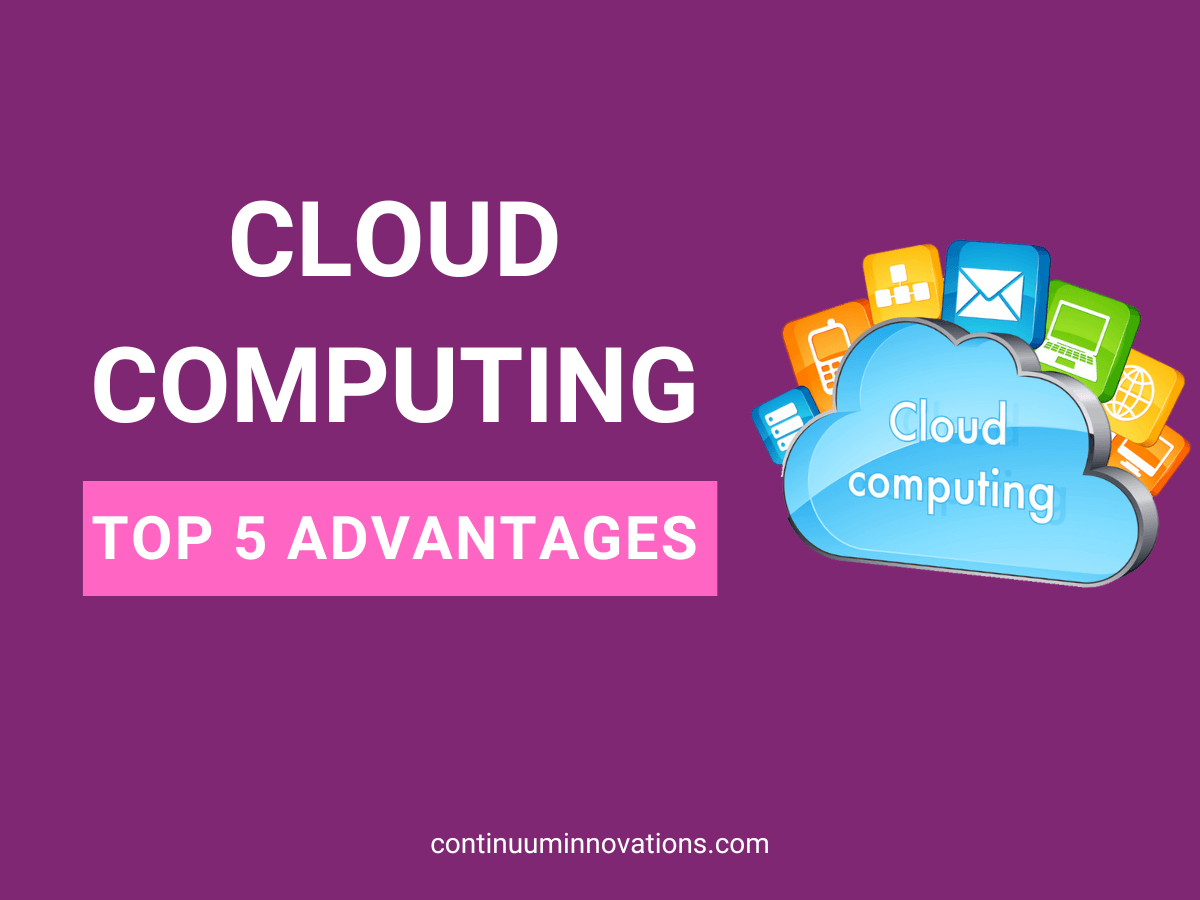Top 5 Cloud Computing Advantages: The Compelling Reasons to Adopt Cloud
Today, more than ever, businesses are required to operate at an unprecedented speed as the technology landscape is evolving rapidly. Simply put, businesses need to innovate faster, transform better, and make the customer experience seamless. All of these requisites are essential, inter-connected, and need a dynamic force to drive them – and that is the cloud. With the cloud computing advantage, businesses can transform their activities while connecting with customers in a more seamless manner.
Cloud is no longer a new trend, it’s an urgent mandate. And the coronavirus pandemic has further propelled this new normal. Amid the pandemic, more and more companies have accelerated their transition to the cloud to reinvent and reimagine how they operate their businesses. Now, the cloud is imperative to realize absolute digital transformation. Now, more than ever, the cloud is crucial to help businesses become cost-efficient, agile, and innovative.
NOTE: According to Foundry’s 2022 Cloud Computing research, almost 70% of organizations have accelerated their cloud journey in the last 12 months, and the organizations with almost all IT infrastructure in the cloud are expected to rise from 41% to 63% by mid of 2024.
So, to be one among the companies in the study, it’s imperative to get to know ins and outs of cloud migration, how it can help your business grow, and what steps should be taken to realize full cloud potential.
In this blog, we reveal the top cloud computing advantages that are compelling the global businesses to adopt the cloud and the best practices for successful cloud migration:
The Top Compelling Cloud Computing Advantages
1.Greater Business Agility & Faster Time to Market
High business agility and less time to market are the most enticing cloud computing advantages. Let’s see how migrating to the cloud helps businesses to leverage these cloud advantages:
The modern, agile working practices enabled by the cloud offer a competitive advantage for businesses. Migrating to the cloud empowers your organization to evolve and adapt itself in terms of its structures, processes, controls, and ways of working.
As customers are a vital part of any business, their inability to access the valuable information resources of the organization can hamper the business innovation. With the power of the cloud to allow anywhere, anytime access to the enterprise data and applications, businesses can bridge the communication and access gaps with their customers, ultimately providing a superior customer experience.
Moreover, as cloud adoption facilitates instant access to digital technologies, particularly advanced services like artificial intelligence (AI) and machine learning (ML), businesses can seamlessly scale up or down in response to demand and opportunity. It enables swift delivery of products or applications, more informed decision-making, and ultimately faster time to market.
2.Better Insights & Decision-making
Businesses, in the present digital world, generate massive amounts of data in raw form, which is of almost no use on its own. The data has to be processed and converted into meaningful information, which should be further turned into insights.
But processing all this data requires huge storage, warehousing, and analytical capabilities. So, for most businesses, it will be challenging to deploy and manage the massive infrastructure required to process the massive amounts of data generated every day. And this is where cloud computing benefits businesses by rescuing their crucial company data. comes to the rescue.
Cloud facilitates the infrastructure required to process enormous amounts of data. So, businesses can now glean deep insights from the raw data. These data-driven insights empower your business to make informed decision, easily and effectively, on everything from supply chain management to customer engagement. This is how the cloud benefits businesses in gleaning meaningful insights and making data-driving decisions.
3.Cost Savings & Demonstrable ROI
Traditional business models are becoming obsolete in terms of their ability to drive ROI. Automation enabled by the cloud can substantially reduce IT and compliance costs.
Moreover, the cloud empowers companies across industries to drive real value through new business models, channels, and services. For instance, in the public sector, the cloud helps organizations to deliver simpler and more effective services and create improved public trust and confidence, while in the IT sector, it enables businesses to gain access to exciting new revenue streams.
However, businesses are required to strike the right balance between innovation and the complexity of the cloud. Balancing the two can fetch 10x times ROI over two years. But, finding the sweet spot between the two is not everyone’s cup of tea. Don’t worry, Continuum Innovations can help you navigate this challenge. With deep expertise and industry presence, Continuum Innovations helps you conquer the cloud challenges and leverage the cloud computing advantage.
4.Security & Data Protection
Security and data protection are one of the most compelling cloud computing advantages that are enticing businesses to move to the cloud.
Cloud service providers offer full-time security expertise and tooling, which is significantly more efficient than a traditional on-premises system, where an organization often focuses on core business activities rather than on security. This cloud advantage is especially enticing for small-to-medium businesses (SMBs), which couldn’t afford enterprise-level security.
DDoS attacks, which are increasing in numbers, magnitude, sophistication, and severity, have become a pain point for businesses of all sorts. Cloud solutions are imbibed with effective security controls, redundancies, customizability, flexibility, scalability, and intelligence to prevent DDoS attacks. Cloud security helps you continuously monitor, identify, analyze, and mitigate any cyberattack.
NOTE: According to RapidScale, almost 95% of companies experienced an improvement in their security posture after moving to the cloud, and over 90% stated that meeting government and compliance mandates is easier on the cloud.
5.Collaboration & Transformation
Cloud helps businesses to realize co-working, co-creation, and co-innovation within and beyond the organization. It allows your employees to work collaboratively from different locations and communicate effectively with customers, suppliers, and partners. In other words, the cloud enables you to share data securely, apply AI models effectively, streamline work processes, and develop new business models.
Moreover, the cloud helps businesses to make people, processes, partners, and technology work in unison. It facilitates the ideal platform, with agility and flexibility, for transforming how your organization operates and reaching customers in new ways. Cloud migration exposes and eliminates the traditional inefficiencies, complexities, and uncollaborated ways of working, enabling the organization to redefine customer experiences.
The Five Crucial Steps to Your Successful Cloud Migration
While the cloud offers a host of business benefits, migration to the cloud is easier said than done. With cloud service providers reimaging and reshaping their cloud offerings with new features and updates, it has become challenging to move to the cloud successfully. You may easily end up in the cross hairs of diverse cloud challenges. But, it needn’t be an overwhelming process. Based on our experience, the following steps can help guide you on your journey to the cloud:

-
Learn
To leverage the cloud computing benefits in the long run, the first and foremost step organizations must take before they embark on their cloud journey is to dig deep and learn about the cloud as much as possible. Understand the benefits, challenges, and complexities associated with the cloud computing journey. Education also plays a critical role in mitigating risks and controlling the proliferation of cloud service usage. Organizations must proactively raise awareness amongst their employees that cloud solutions can have fundamentally different management requirements and considerations from traditional on-premise deployments.
-
Plan
The next step is to identify the business objectives and make a prioritized cloud migration plan to achieve them. Prioritizing the workloads the company wants to move to the cloud and those that be moved later will form the next steps. Identify the gaps your organization may have in its cloud capabilities and draft a roadmap to remediate those risks. Planning allows users to leverage the cloud computing benefits while providing a sound vision to identify the cloud issues that need to be resolved.
-
Formalize
The third step is to formalize a cloud adoption. With a cloud migration plan and strategy at your disposal, you can formalize cloud adoption through the development of cloud policies, standards, and an operating model. The purpose of cloud policies is not to limit, but to help organizations drive value from their cloud investments. Consider both the current and future cloud requirements and take a proactive approach to develop cloud policy.
-
Adopt and manage
Once the groundwork is finished, the next step is to adopt and implement the tools required to provision and manage the selected cloud solutions. The three fundamental capabilities needed to effectively manage the cloud solutions are self-service cloud provisioning, IT orchestration management, and financial management.
-
Evolve
The final step in the cloud journey is to take full leverage of the capabilities and IT environs the organizations have cultivated. The highly scalable and on-demand nature of the cloud empowers you to experiment and innovate. The cloud provides avenues for organizations to re-envision business processes and develop a proof of concepts with minimal investment and negative impact.
The Final Thoughts
When done right, your organization can fully leverage the cloud computing advantages. However, to be done right, you must approach the cloud with clarity of vision and objectives, knowledge of business drivers and impediments, proper planning and execution, and continuous governance and management.
In today’s environment of constant change, it is almost impossible to keep up with all the developments in the cloud ecosystem. Evolving cloud solutions and constant innovation seem to offer numerous opportunities, but also numerous ways to get things wrong. Amid this uncertainty Continuum Innovations can help you get things right—and start really “thinking cloud” while leveraging the benefits of cloud computing at full potential.


